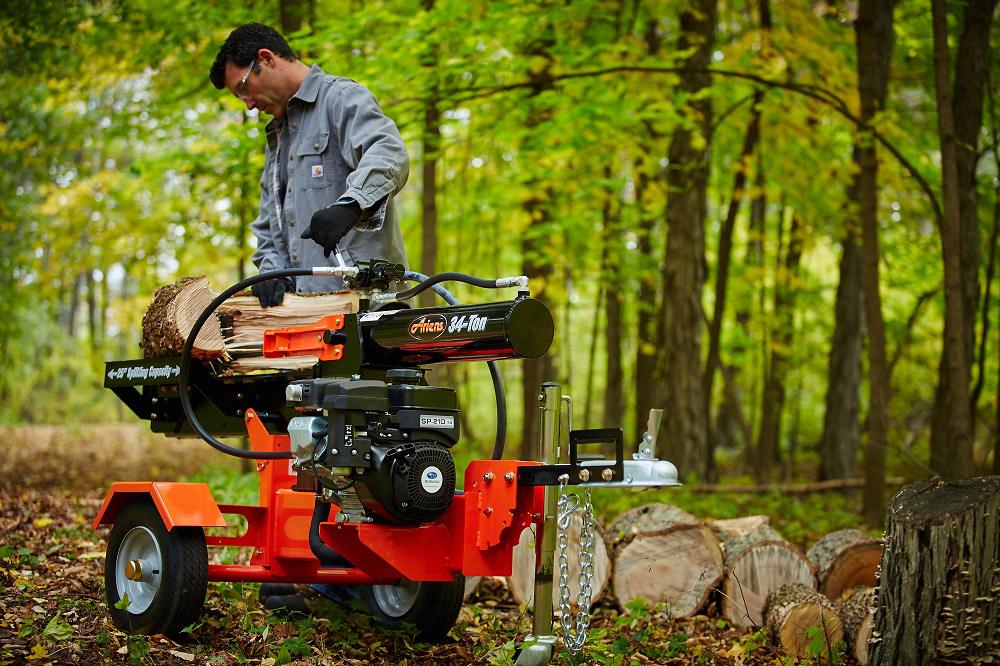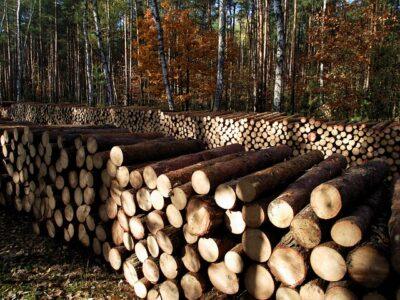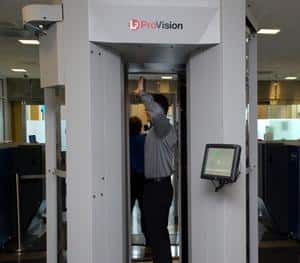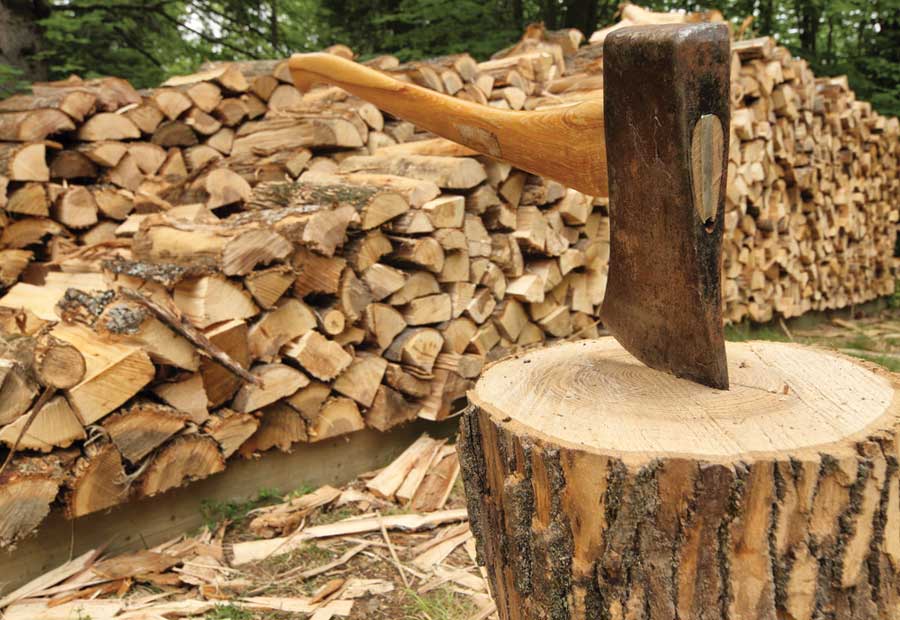
There are a lot of variables involved in splitting firewood for heat. Methods vary widely, depending upon individual needs and skills and upon the wood itself. There are still some people out there who split wood by hand, either because their firewood is soft, or they don’t use much of it, or they are just plain tough as nails. For people like me, who do not fit into any of those categories, there are many machines available for splitting wood.
If you are in the market for purchasing equipment for splitting wood at home, there are some useful things to know before you shop.
First, a few words about terminology. I refer to the piece of equipment I use to split firewood as a “wood splitter,” but you will not find that anywhere online. Instead, you will find “log splitters.” I am unsure whether my term is a regionalism or just old-fashioned, and would be interested to know if there are others who call it a “wood splitter.” For ease of communication, I shall call it a “splitter” for this article.
Splitters come in a variety of types, styles and price ranges. You can purchase a manual rig for around $100 or a high-end machine for many thousands. The one you choose will depend upon your firewood needs, log availability, time, skills and budget.
Discover More Than 1,100 Homesteading Tips And Tricks!
The manual splitters on the market comprise an assortment of simple machines which are basically adapted axes with additional safety features and effort-reducing torque designs. Foot- or hand-powered levers operate an axe, which slides along a metal table or cradle where the wood to be split is placed. The work yield is improved by levers, hydraulics, and ingenious designs, but these splitters are not intended for use with a large volume of firewood. They may disappoint when used for harder varieties of wood or larger pieces, as they are marketed for light use.
For certain situations, however, these splitters are just the ticket. For example, a manual splitter might serve a household well if their firewood needs for the season amount to just a small amount of softwood, or if they buy most of their firewood already cut and split and need only to trim up a few pieces, or if they are able to accomplish most of their splitting with a weekend rental.
On the other end of the spectrum are high-powered commercial wood processors. These machines are fast, powerful, highly automated and expensive. They cut full length logs and then split them quickly with minimal human effort. Big pieces of equipment such as these are intended for those who cut a large volume of firewood — particularly for commercial ventures — and such an investment is not likely to be justifiable for most ordinary homeowners.
Most of the splitters designed for backyard and homestead use are somewhere in between. These homeowner models can be roughly divided into four categories: freestanding gas-powered in either standard or flywheel type, and as attachments on a skid-steer or tractor.
Standard-type freestanding gas powered models are probably the most common. They vary in size, force and price. Measured by tons, the available force ranges from around 8 tons to 35 tons or more. Prices start around $500 and reach $5,000 and up.
As with any machine, the more a person will use it and the more money and effort will be saved by having it, the more sense it makes to own one.
Firewood usage depends upon many factors, from the size and insulation of the house to the quality and dryness of the firewood. The type of wood burner matters a great deal, too, whether it is a tightly-sealed highly efficient stove or a drafty fireplace or a state-of-the-art outdoor wood burner. Even the site of the wood-burning appliance matters, as well as the skills and diligence of those using it.
All that aside, it is reasonable to figure that an average-sized home in a northern climate will burn between five and 12 cords of wood a year. That volume of firewood can easily be handled with a moderate-sized splitter in the range of 20 to 27 tons. Standard styles in this size sell new for between $1,000 and $1,700 at major dealerships and big-box stores.
Freestanding gas-powered models work basically like this: the round section of firewood which has been cut to stove length, or “bucked up,” fits onto the table or cradle. The motor drives a hydraulic cylinder, which closes the gap between a cast-metal wedge and a vertical plate on the other end of the table, and splits the wood between them. On most of these models, the wedge moves towards a stationary plate, but a few manufacturers do it the other way around, with a traveling push plate and a stationary wedge. Either way, it is operated with ease by a handle on the side of the splitter.

The moving part travels fairly slowly on most standard mid-range models. That is probably a good thing safety-wise for the forward motion, but it can be tedious on the return. Half of my wood-splitting time is spent waiting for the wedge to retract enough to begin the next cut.
At a fair a few years ago I happened upon a salesman demonstrating a flywheel-type gas-powered splitter, also called a kinetic splitter. I was so astonished at the speed with which the wedge retracted that I watched the demo over and over, and eagerly gathered up a handful of promotional materials.
“He had you at three-and-a-half second return,” my husband joked. But when I checked out the dealership website later, I suffered a little sticker shock. The equipment is fast—and mostly on the return cycle, where it is less of a safety issue and more of a time-saving one—and by design is also super-efficient, but it is expensive. Lower-end models start at higher prices than most standard models and go up quickly, but are nonetheless the perfect choice for many homesteads.
The range for attachment-type splitters is similar to that of freestanding models. These types do not have their own power source, but instead attach to other equipment for power. Most of the attachment types are made for tractors, but a few are made for skid-steers as well.
Make Sure Your Electronics ALWAYS Have Power … With The New Pocket Power X!
Ton for ton of maximum force, attachment types cost less to buy. However, it is a little more complicated than that, because splitter performance depends upon the power equipment’s hydraulic capacity, as well. It is important to assess the capability of your tractor or skid-steer before committing to a splitter attachment, and asking your dealer or repairperson is a great idea if you are unsure of how to match the right model attachment to your tractor or skid-steer.
If you have the equipment necessary to operate an attachment type splitter already, that may well be the best way to go.
Nearly all splitters operate in either horizontal or vertical mode and can be easily changed from one to the other. There is no right or wrong, but merely whatever the user is comfortable with and is able to do. Larger logs can more easily be slid under the wedge with the splitter in the vertical position, but smaller pieces can be done either way.
Brand names are something to be considered. On freestanding types, the manufacturer of the engine is particularly important to some, and can have a significant impact on the price, as well. If you have a favorite engine maker and are willing to pay a little extra for it, go ahead and do so.
If you are unfamiliar with splitter operation, it is crucial to seek instruction and guidance as part of your shopping experience. All types of splitters are powerful machines and can cause severe injury if used incorrectly.
Large or small, manual or full-feature, freestanding or attachment — there are a lot of wood splitters to choose from and many decisions to make when making a purchase. A careful assessment of your needs, skills and budget can help you choose the best possible equipment for you and your homestead, and will help you keep your family warm in winter for years to come.
What advice would you add on buying a log/wood splitter? What type do you own? Share your thoughts in the section below:
Discover The Secret To Saving Thousands At The Grocery Store. Read More Here.










